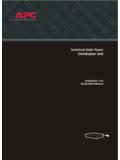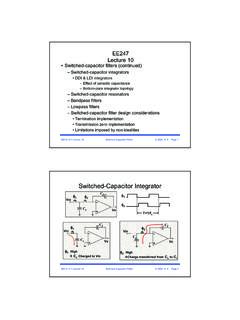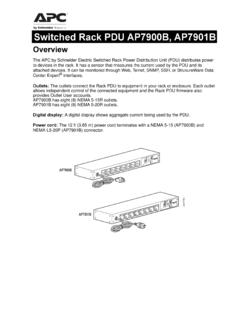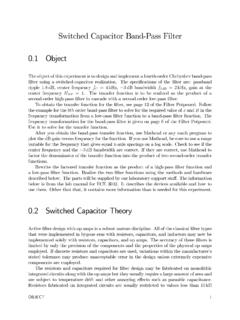Transcription of CHAPTER 8 BACKBONE NETWORKS - Jake Messinger
1 CHAPTER 8 BACKBONE NETWORKS CHAPTER Summary This CHAPTER examines BACKBONE NETWORKS (BNs) that are used in the distribution layer (within-building backbones) and the core layer (campus backbones). We discuss the three primary BACKBONE architectures and the recommended best practice design guidelines on when to use them. The CHAPTER ends with a discussion of how to improve BN performance and of the future of BNs. Learning Objectives After reading this CHAPTER , students should: Understand the Internetworking devices used in BNs Understand the switched BACKBONE architecture Understand the routed BACKBONE architecture Understand Virtual LAN architecture Understand the best practice recommendations for BACKBONE design Be aware of ways to improve BN performance Key Terms chassis switch forwarding equivalence class (FEC) IEEE label switched router (LSR) layer-2 switch main distribution facility (MDF) module multiprotocol label switching (MPLS) multiswitch VLAN patch cables rack routed BACKBONE router single-switch VLAN switched BACKBONE virtual LAN (VLAN)9 VLAN ID VLAN switch VLAN tag VLAN trunk Instructor s Manual to Accompany: Business Data Communications and Networking, 12e by Fitzgerald/Dennis 2015 John Wiley & Sons, Inc.
2 Page 1 CHAPTER Outline 1. Introduction 2. switched Backbones 3. Routed Backbones 4. Virtual LANs 5. The Best Practice BACKBONE Design 6. Improving BACKBONE Performance a. Improving Device Performance b. Improving Circuit Capacity c. Reducing network Demand 7. Implications for Management 8. Summary Answers to Textbook Exercises Answers to End-of- CHAPTER Questions 1. How does a layer-2 switch differ from a router? Layer 2 switches operate by using the data link layer address or MAC address to forward packets between network segments. They connect the same or different types of cable. Layer-2 switches (or workgroup switches) operate at the Data Link layer, and typically provide ports for a small set of 16 to 24 computers. Layer-2 switches enable all ports to be in use simultaneously by managing paired combinations of ports as separate point-to-point circuits.
3 Layer-2 switches "learn" addresses; a layer-2 switch builds a forwarding table after it is first turned on. To learn addresses, a layer-2 switch retransmits to all ports (except to the one from which it was received) only for a packet with a destination address not already in the forwarding table. The resulting ACK from the destination computer (that recognized its address) is then used by the layer-2 switch to add the new port number and address to the forwarding table. Routers operate at the network layer. They connect two different TCP/IP subnets. Routers strip off the data link layer packet, process the network layer packet, and forward only those messages that need to go to other NETWORKS on the basis of their network layer address. In general, they perform more processing on each message than switches and therefore operate more slowly. 2. How does a layer-2 switch differ from a VLAN?
4 Layer 2 switches operate by using the data link layer address or MAC address to forward packets between network segments. They connect the same or different types of cable. Layer-2 switches (or workgroup switches) operate at the Data Link layer, and typically provide ports for a small set of 16 to 24 computers. Layer-2 switches enable all ports to be in use simultaneously by managing paired combinations of ports as separate point-to-point circuits. Layer-2 switches "learn" addresses; a layer-2 switch builds a forwarding table after it is first Instructor s Manual to Accompany: Business Data Communications and Networking, 12e by Fitzgerald/Dennis 2015 John Wiley & Sons, Inc. Page 2 turned on. To learn addresses, a layer-2 switch retransmits to all ports (except to the one from which it was received) only for a packet with a destination address not already in the forwarding table.
5 The resulting ACK from the destination computer (that recognized its address) is then used by the layer-2 switch to add the new port number and address to the forwarding table. VLAN switches work a little differently. When a VLAN switch receives a frame that is destined for another computer in the same subnet on the same VLAN switch, the switch acts as a traditional layer-2 switch: it forwards the frame unchanged to the correct computer. VLAN switches use Ethernets s tagging to move frames from one switch to another. When a VLAN switch receives an Ethernet frame that needs to go to a computer on another VLAN switch, it changes the Ethernet frame by inserting the VLAN ID number and a priority code into the VLAN tag field. 3. How does a router differ from a VLAN? VLAN switches can create multiple subnets, so they act like routers, except the subnets are inside the switch, not between switches.
6 Therefore, broadcast messages sent by computers in one VLAN segment are sent only to the computers on the same VLAN. 4. Under what circumstances would you use a switched BACKBONE ? switched backbones can be used in situations where the network administrators wants to spread the traffic around the network more efficiently. In addition, it also provides an architecture where network capacity is no longer tied to the physical location of the computers, as computers in 5. Under what circumstances would you want to use a routed BACKBONE ? Routed backbones are good for connecting different buildings on the same enterprise campus BACKBONE network . The primary advantage of the routed BACKBONE is that it clearly segments each part of the network connected to the BACKBONE . Each segment has its own subnet addresses that can be managed by a different network manager. Broadcast messages stay within each subnet and do not move to other parts of the network .
7 6. Under what circumstances would you use a VLAN BACKBONE ? A VLAN BACKBONE is useful when you want to put computers that are in different geographic locations in the same subnet. In addition, VLANs make it much simpler to manage the broadcast traffic and provide a better opportunity to prioritize traffic on the network . 7. Explain how routed backbones work. Routed backbones move packets along the BACKBONE based on their network layer address ( , layer 3 address). The most common form of routed BACKBONE uses a bus topology ( , using Ethernet 100 Base-T). Routed backbones can be used at the core or distribution layers. Instructor s Manual to Accompany: Business Data Communications and Networking, 12e by Fitzgerald/Dennis 2015 John Wiley & Sons, Inc. Page 3 At the core layer routed backbones are sometimes called subnetted backbones or hierarchical backbones and are most commonly used to connect different buildings within the same campus network .
8 At the distribution layer a routed BACKBONE uses routers or layer 3 switches to connect a series of LANs (access layer) to a single shared media BACKBONE network . Each of the LANs are a separate subnet. Message traffic stays within each subnet unless it specifically needs to leave the subnet to travel elsewhere on the network , in which case the network layer address ( , TCP/IP) is used to move the packet. 8. In Figure , would the network still work if we removed the routers in each building and just had one core router? What would be the advantages and disadvantages of doing this? The network would still work, although the traffic on the network would be significantly increased due to the creation of one large LAN instead of three subnets. The advantages of this would be slightly lower costs due to only purchasing one router instead of four and less maintenance and management.
9 Each of these advantages are minor, and certainly not work the additional traffic on the network . 9. Explain how switched backbones work. switched BACKBONE NETWORKS use a star topology with one device, usually a switch, at its center. The traditional BACKBONE circuit and set of routers or bridges is replaced by one switch and a set of circuits to each LAN. The collapsed BACKBONE has more cable, but fewer devices. There is no BACKBONE cable. The BACKBONE exists only in the switch, which is why this is called a collapsed BACKBONE . The original collapsed BACKBONE technology uses layer-2 switches and suffers some disadvantage due to the load of data link layer overhead message traffic and limitations on network segmentation. As this weakness has been recognized, collapsed BACKBONE technology is adapting by evolving to the use of layer-3 switches to overcome these problems. The result is better performance and improved network management capabilities for switched BACKBONE NETWORKS .
10 Collapsed backbones are probably the most common type of BACKBONE network used in the distribution layer ( , within a building). Most new building BACKBONE NETWORKS designed today use collapsed backbones. They also are making their way into the core layer as the campus BACKBONE , but routed backbones still remain common. 10. What are the key advantages and disadvantages among routed and switched backbones? Advantages Disadvantages Routed backbones Clear segmentation of parts of the network connected to the BACKBONE as each network has a subnet address and can be managed separately. Slower performance as routing takes more time than bridging or switching. Management and/or software overhead costs due to need to establish subnet addressing and Instructor s Manual to Accompany: Business Data Communications and Networking, 12e by Fitzgerald/Dennis 2015 John Wiley & Sons, Inc.









